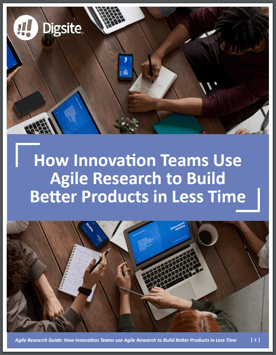Today’s leading organizations are increasingly employing agile approaches to developing new marketing programs, product or service innovations and customer experiences. By leveraging agile market research methods, your organization is able to simultaneously design, test and build new solutions before going to market. This approach speeds time to market, while still ensuring your go-to-market strategy fits with consumers’ lifestyles, situations and needs.
Our monthly blog post offers practical tips and advice on how to implement agile research. February's agile tips are centered around the ways in which you can stay focused throughout your research and are provided by Whitney Snow, an independent marketing consultant and one of Digsite's expert consultants.
Tip 1. Define Your Project Objectives
One key to effectiveness in agile research is to stay focused on your learning objectives throughout your research. Discuss your team's biggest decision “blockers” and use those to get alignment on project objectives upfront.
Share your key objectives with your entire team and call out areas you are not prioritizing to avoid a misalignment on projects. Keep the team disciplined to make sure every research activity and question ties back to your project objectives.
Tip 2. Test Early and Often
The intent of agile is to learn as you build solutions with your consumers. But if you're always solely focused on what to test and not how it all works together, it can slow the project down. You don’t always need to show participants something “perfect” to get their feedback. If you don’t have pictures or stimulus - have consumers build solutions that help you see and understand what is important to them.
Tip 3. Stay Focused on Your Primary Goal
It’s easy to get derailed by other learning throughout your research – but don’t try to do too much in your research window. Think about what you need to know vs. what you have time to learn and what you can act on.
Decide on the few things that are most important, and then ask the team what they “think” the research participants will say or do. This will help you identify areas you might need to drill deeper on, and you’ll get the rich insights you need to move forward.
Tip 4. Clearly Define Your Target Audience
Agile research is typically most successful when you talking to fewer targeted participants vs. a large general audience. Why? If you aren’t talking to people who have the specific problem you are solving, their responses won’t help you build or optimize your solution. However, it’s just as easy to over-define your target audience as it is to under-define your audience.
For example, attitudinal targeting is often misleading as people tend to act differently on various occasions. So, focus on a few of the most important targeting criteria – you can always adjust your audience for your next test based on what you learn.
To learn more about how your organization can make the move to agile research, here are some resources to check out:
- Agile Research Guide: How Teams Can Innovate Faster
- How to Build an Effective Agile Research Team
- How Leading CPG Companies Use Online Qualitative Research for Better Business Outcomes
To see how four real-world companies are moving away from costly and time-consuming stage-gate development processes and prioritize innovation while operating with agility, check out our new eBook: How Innovation Teams Use Agile Research to Build Better Products in Less Time.





